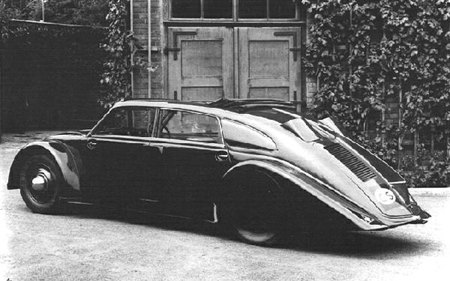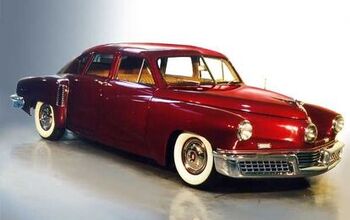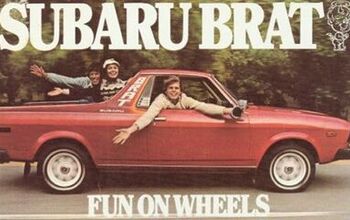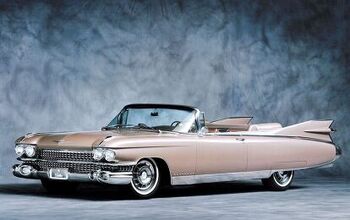A Brief Illustrated History of Tatra

The dorsal fin is what put it over the top for me, literally. When I was a tyke of six in Austria, I ogled cars like a fifteen year old with X-ray vision at a cheerleading camp. But the most tataliscous bod my eyes could never get enough of was the Tatra down the street. Its radical aerodynamic form was already twenty years old, but with its dorsal fin, tear-drop shape, rear engine and uncompromising fluid lines, the Tatra positively screamed “futuristic” to me then. Hell, it’s still ahead of the times today.
The Tatra 77 of 1934 was as slippery as a politician; its cD (coefficient of drag) of .21 was well below the cD .26 of today’s aero-champ, the Prius. Austrian-born Hans Ledwinka, chief designer/engineer at the Czech firm created a sensation with the 77. Inspired by the automotive aerodynamic principles of Paul Jaray, the brilliant Ledwinka created a truly original vehicle the likes of which had never been seen, not to mention sold.
With its rear air-cooled OHC hemi-head V8 engine, back-bone chassis, all-independent suspension, a central driver’s position and a central headlight that swiveled with the front wheels, the 77 (and its successor 87), inspired awe as well as imitation. I’m looking at you, Mr. 1947 Tucker Torpedo. The Tucker flopped, but another Tatra mini-me went on to become the world’s most popular car: the VW Beetle.
Ferdinand Porsche’s design of the Beetle is a scaled-down version of the Tatra (minus the fin). So much so that after decades of legal battles, VW finally settled and paid 3 million Marks to Tatra in 1961. (Ledwinka’s four-cylinder Tatra 97 was so embarrassingly similar to the VW then under development that the Nazi regime halted its production after their invasion of Czechoslovakia.)
But not the glorious 87. After the Nazis took control of the Tatra factory, they kept the V8 streamliner in production. Thanks to its ability to cruise effortlessly at up to 90mph (with only 75hp), the 97 became the favorite car of high-ranking Nazi officers. It was dubbed the “Autobahnmobil.”
More ominously, the 97 was also dubbed “the Czech secret weapon” after many of these high-speed demons died at the hands of the wickedly-abrupt “terminal” oversteer of the tail-heavy V8. Hitler reputedly banned his top Luftwaffen officers from 97 seat time to forestall the recurring carnage.
After the war, the communist-era planned economy presented serious challenges to Tatra. The T-87 was made for a few years, but the post-war economy was too austere for V8’s. So the smaller T-97 was resurrected and updated. The resulting four-cylinder T-600 Tatraplan was exported to the west in modest numbers (including the object of my childhood obsession) during the early fifties.
But Tatra was not equipped for efficient mass production. After a few years, the communist big-wigs instructed tatra to build them a luxobarge. The dorsal fin gave way to (two) rear windows; the rest of the car was substantially updated. The automaker produced the T-603 from 1955 through 1975.
When my family emigrated to America, I thought I’d left Tatras behind forever. Little did I know that 603’s would develop a huge cult following. The only thing keeping it from being the official car of Jalopnik.com is the thus-far presumed lack of a pick-up version (“Tatramino”). But a closer inspection of the website reveals the existence of that long-sought Czech Holy Grail. Time to make it official Jalops!
Tatra 603’s have found their way into the movies, including a star turn as a sinister sedan in “Lemony Snicket’s A Series of Unfortunate Events.” The multi-talented 603 was also the star of a highly-camp communist-era promotional infomercial. The 603 shows its hooning prowess, eluding the police with lots of tail-out oversteers and a daring sideways roll down a steep meadow (Youtube: Tatra 603 Happy Journeys Part 1 & Part 2“).
The evergreen 603 recently had a new role, as the host for new interior concepts by industry supplier Faurecia. Sadly, its drive train was sacrificed to show off some new trunk technology.
By the mid seventies, the aero-look was passé. The 1974 T-613 successor sported sharp-edged styling by Vignale of Italy. But Ledwinka’s basic formula stayed intact, right through 1996. It was the upscale, high performance corollary to the similarly boxy VW 411. After the fall of Communism, once again, mostly futile efforts were made to sell the 613 in the west, as a BMW competitor.
Recent efforts to revive the boxy T-613 have failed. But with the new-found emphasis on efficiency and aerodynamics, it’s time to dust off those old body dies of the T-77. With a clean turbo-diesel under that dorsal fin, it could be just the ticket back to the future.

More by Paul Niedermeyer
Latest Car Reviews
Read moreLatest Product Reviews
Read moreRecent Comments
- Bd2 Ultimately, it comes down to price/whether it makes financial sense for buyers (right now, BEVs just aren't there, even with the tax credit). HEVs are finally seeing their place in the sun, decades after being a niche market; this is due to premium for HEVs having narrowed significantly with pure ICE, whereby buyers can recoup that after 2-3 years of ownership.
- MaintenanceCosts I've experienced three cars that were the first year of the model. The two I bought (first-off-the-boat 2004 TSX and midyear 2006 Civic) were both Hondas and were both flawless. The other one was my ex-stepmother's 1990 Land Rover Discovery. It was one of the very first Euro-spec models, a two-door with an asthmatic carbureted 3.5L V8 and a five-speed manual. Every part of the car broke at some point, including things like hatch hinges that really shouldn't break. It turned her off Land Rover forever, and her cars since have all been Subarus.
- MaintenanceCosts When I was living with my Bolt in a rental condo and charging from 120V in the garage, as soon as the association figured out what was happening, they asked me to pay $30 a month to cover the cost. That's pretty close to what I was using so I had no issue with it.
- SCE to AUX I've had mixed results with first-year cars:71 Pinto - good. 85 LeBron GTS - good. 96 Grand Voyager - good. 02 Passat B5.5 - bad. 05 Odyssey - bad. I also had a last-year car that was terrible (80 Bobcat), but most cars were crap then, anyway.
- Crown Go big or go home. Never understood the "economy version" that manufacturers make of a performance car.






































Comments
Join the conversation
Small planet indeed!!! Found that book I mentioned above - Julius Mackerle: Air-Cooled Automobile Engines, The Institute of Mechanical Engineers, London 1961-2 http://en.wikipedia.org/wiki/Julius_Mackerle Occasionally one appears on various book websites for cheap. Then there are the $500 copies always available. Good read. LOTS of detail. Perhaps they are more common on UK book reseller sites?
In case you haven't heard, a 1941 Tatra, still driven by its 55 year old owner in Los Angeles, won the New York Times 2010 Collectible Car of the Year Contest this past July. The winner and 30 finalists were chosen by readers of the online Automobiles pages. http://www.nytimes.com/2010/07/25/automobiles/collectibles/25contest.html?_r=2 (I think that registration to the Times is required to read the article.)